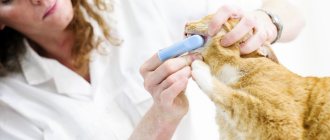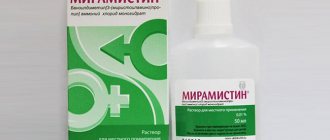When it is difficult for a cat to take a pill, an introducer will help. Thanks to the tool, there is no need to squeeze your fingers into your pet's mouth to place the medicine on the root of the tongue. Calm cats take medications normally. They adapt to evil animals so that the process is successful and without injury. A couple of simple steps will help. The instructions will tell you how to take the medicine correctly - whether the bitter tablet can be crushed or whether it needs to be consumed entirely.
Is it possible to add veterinary drugs to food?
If a cat is categorically against taking a medicine, the first thing that comes to mind is to mix it into its food. But this is not the best idea for a number of reasons:
- Not all veterinary medications can be mixed with food; some are taken strictly on an empty stomach. Products in special shells and capsules cannot be divided into parts and crushed, since they are intended for absorption only in the stomach and not in the oral cavity. Be sure to check with your veterinarian or instructions on how to take a recommended product before adding it to your food.
- Many products have an unpleasant taste, and cats have an excellent sense of smell and very sensitive taste buds. If you hide a pill inside a piece of meat, the animal, as a rule, masterfully manages to eat the delicacy and leave the medicine itself untouched.
- A finely crushed tablet or liquid mixed with wet food also does not always give the expected result. Even if your pet starts to eat, he may soon sense something is wrong and move away from the bowl. Thus, the owner cannot control how much of the drug is eaten, which will only complicate the matter.
To properly give medicine to a cat, it is better to act without tricks. How to do this depends on the prescribed dosage form. It is easier to give liquids and suspensions from a syringe, and tablets using tweezers or a “pill dispenser” (introducer).
What to feed a sick cat
In the advanced stage of any disease, the cat refuses to eat. There can be many reasons: loss of strength, nausea, pain during chewing, loss of smell, lack of a swallowing reflex, injury or inflammation of the throat, etc. Hunger quickly leads a cat to exhaustion, and if the pet still doesn’t drink, then to dehydration.
Feeding a sick cat requires an individual approach , since you need to clearly understand the needs of the body and adapt to them. Without permanent consequences, a cat can fast for 24 hours, but a noticeable slowdown in metabolism will occur after 12 hours.
Note! A slowdown in metabolism leads to less production of leukocytes and a decrease in the body’s cleansing function... in other words, loss of strength and progression of the disease.
Almost always carbohydrates , since, while fighting the disease, the pet loses weight. It is important not to overdo it, since the body also wastes energy not processing carbohydrates. To help your pet you need to provide him with the most comfortable conditions, warmth and eliminate the need to move around his home.
The type and method of nutrition is selected taking into account the maximum number of consequences of the disease. The minimum that needs to be taken into account is:
- Weakened intestinal microflora - almost always, if a cat has a fever, colonies of friendly bacteria die en masse. Visually this is not noticeable, but the consequences will not take long to appear - the cat will have indigestion. Conclusion - food should be easy to digest.
- Exhaustion - the body of a sick cat throws all its resources into fighting the disease, so the fur, skin, and some mucous membranes are left without the usual nutrition. Conclusion - food should be nutritious.
- Irritation of mucous membranes - in cats, the mucous membranes of the eyes, nose and mouth interact almost instantly, that is, if the eyes, throat and throat are irritated. Many pets refuse to eat simply because they have difficulty swallowing. Conclusion - food should be warm, liquid or crushed and soft.
How to give a cat medicine from a syringe
The problem of how to give a cat liquid medicine can be solved very simply: just buy an ordinary disposable syringe at the pharmacy and remove the needle from it. The syringe is calibrated in cubic centimeters. 1 cu. cm is equal to 1 ml.
Before manipulation, draw the required amount of liquid into the syringe in advance, and then secure the animal. It is better if an assistant does this, but if one is not available, you can swaddle the animal in a towel to protect yourself from sharp claws.
The tip of the syringe is carefully inserted into the side of the jaw - just behind the fang, where there is a fairly wide gap between the teeth. With your left hand, hold the cat's head slightly elevated, but not tilted upward.
If the animal behaves calmly, then it is enough to clasp its neck with your palm from below and with an outstretched index finger lightly press the jaw upward, preventing the head from lowering. The medicine from a syringe should be given slowly, in small portions, each time waiting for the cat to swallow, and lightly stroking its throat from top to bottom with the same index finger.
Make sure that the stream of liquid is directed strictly perpendicular to the jaw, and not into the throat, otherwise there is a high risk of moisture getting into the respiratory tract.
Sometimes during the procedure, the furry patient begins to drool. This is considered normal, but part of the active substance leaks out along with saliva, therefore, you have to slightly increase the dosage.
Method 2. Give in powder
Most cats are very sensitive to foreign substances in their food and refuse to eat, even going on hunger strike. If this is your case, then try crushing the tablet into a powder and then pouring it into the cat's mouth.
Of course, there is no need to wait for the voluntary opening of the mouth - just place your palm on the pet’s head and squeeze the cheekbones on both sides (from the side of the molars). The animal will reflexively open its mouth, at this moment you need to quickly pour the powder deeper, close its mouth, and hold for 2-3 seconds.
How to get a cat to swallow a pill
Many readers are concerned about the question of how to properly give medications to cats, for example, anti-worm medications in tablet form. It's a little more difficult, but nothing is impossible.
Often, owners simply do not know how to open the cat's mouth to give medicine, and act incorrectly. In fact, it is much easier to perform this action in relation to a cat than, for example, in relation to a person whose jaws do not protrude forward.
So, grab the animal’s head from behind with your hand, insert your thumb and forefinger between the lips at the corners of the jaw and lightly press on them. The cat's mouth will open slightly, and at this moment you need to quickly place the tablet on the root of the tongue - if you hit exactly this spot, the swallowing reflex will instantly work. Immediately after this, lift the cat’s head and stroke its neck from top to bottom, without allowing it to open its mouth.
For those who find this quite difficult or the cat actively resists, you can use an auxiliary tool - an introducer, or simply a “pill dispenser”. This device resembles a syringe with a plunger and a soft tip with several slits.
A tablet is placed inside the tip, and the piston pushes it into the animal’s mouth. To make it easier to swallow, you can add a little water to the tip along with the pill.
Tips that may be useful:
How to give a tablet or capsule to a cat?
- If the tablet has a dry, powdery surface, it will slide through more easily if it is coated with a little margarine or butter. You can also use lard or other non-solid fat.
- If the tablet is large, it will be easier to feed it by first breaking it into small pieces, but you should not do this without first checking the label on the drug or consulting with your veterinarian. This is because some medications may lose their effectiveness if the tablet coating is damaged.
- If a cat owner is afraid that his pet might bite his fingers when he gives her a capsule or tablet, then he should use a special device that can make the process of taking medication easier. In appearance it looks like a syringe. Its design is such that a tablet is inserted into one hole, and on the other side there is a piston, similar to the one found in a syringe. By pressing the piston, the tablet is sent under pressure into the cat's mouth.
Emotional mood
Do not forget to calm the cat throughout the procedure by talking affectionately to it. This works best if you imagine that in front of you is a very small child who does not yet speak, whom you persuade to eat another spoon “for dad” and “for mom.” At the same time, women instinctively raise their voices and develop gentle melodious intonations.
Naturally, you can say whatever you want and even perform children’s sayings and nursery rhymes - practice shows that they have the same calming effect on cats as they do on babies. Try not to be nervous yourself, behave calmly and confidently, and we hope our advice will help you with this.
What to feed a newborn kitten
Blind babies are very sensitive to the fat content and composition of food. If the kittens were separated from their mother immediately after birth, their intestines will be populated by the microflora that will be in the first product they eat (drink). Under natural conditions, a cat feeds babies with colostrum , but with artificial feeding this is impossible.
Note ! Not so long ago it was believed that kittens could be fed with cow's milk; today this method is sharply condemned. However, this does not change the facts; kittens are fed diluted cow's milk and even store-bought milk. Yes, babies have less chance of survival, but they do exist.
Goat milk , also diluted with boiled water, is more acceptable. The fact is that goat milk has a stronger and richer microflora. To make it clearer, it is bacteria, their numbers and vitality that play the main role in the digestion of food. It is for this reason that kittens often die from store-bought milk - it is pasteurized, that is, it does not contain bacteria... we can say that it is dead.
Rules for giving pills
A cat is a wayward creature, resisting any violent actions on the part of its owner. Inexperienced fellinologists believe that their pet will take the tablet (tabula) offered to him or that they will be able to force the animal to swallow a tasteless wheel. A solid dosage form that gets onto the root of the tongue causes profuse salivation.
The operator is positioned on the floor, kneeling. The cat is placed with its muzzle away from you and secured so that it cannot escape.
The tablet is clamped in the fingers of the right hand (if the operator is right-handed) or placed in a tablet dispenser. Another hand is placed on the cat’s head, tilted back, and simultaneously pressed on the articulation of the jaws. When opening the mouth, the tablet is pushed onto the base of the tongue. The mouth is forcibly clamped, the throat (faucibus) is stroked from top to bottom, waiting for the swallowing reflex.
They unclench their jaws, making sure that there is no pill in their mouth. A variant of this method is to place the cat on a windowsill or table.
The pet is wrapped in a towel, fixing its paws. Place the animal on your left hand and place the tablet in its mouth using the method described above.
The animal is placed on your knees with its muzzle facing you. They stroke the belly, relaxing and calming the cat. The left hand is placed on the head, thrown back, and the mouth is opened with the help of the thumb. Place the prepared tablet in the oral cavity. Stroke the throat with the fingers of the right hand. Observe the sip and check whether the medicine is swallowed.
Effective anthelmintic drugs for cats
Every loving owner strives to take care of their pets. And first of all, you need to pay attention to the health of your pets. Many cats walk outside on their own, where they can pick up infections. The most common disease in animals is worms. Therefore, every caring owner must correctly select effective deworming tablets for cats.
Worms are also dangerous because they can be transmitted from cats to people, including small children, because kids love to play with kittens.
Symptoms of worm infection
Depending on the degree of infection, one or other signs appear. If there are few parasites in the cat’s body, then there may be no symptoms of infection at all.
The main signs of infection are as follows:
Our readers successfully use Intoxic to get rid of parasites. Seeing how popular this product is, we decided to bring it to your attention. Read more here...
- diarrhea or constipation;
- vomiting, and the vomit must contain worms or blood;
- the presence of worms in feces;
- weight loss;
- the presence of blood or mucus in the stool;
- cough;
- premature birth in cats;
- difficulty breathing;
- The kitten is developmentally delayed.
Safety rules for hosts
What measures should the owner take to avoid injury during the treatment of the cat? You can make such procedures safer by observing the following rules:
- Do not feed the tablets to cats alone. The risk of injury is significantly reduced if different people give medications and hold the pet.
- Wear gloves made of thick material. They will be useful to the one who will keep the animal.
- Use towels or blankets to securely hold the cat. Sometimes even calm and balanced pets are capable of aggression if they sense danger, so additional restraint is simply necessary.
- It is better to prepare medications and remove tablets from the package in advance and not in the room where the pet is.
- Do not give medicine to your cat if it is under stress. Before the procedure, you need to calm her down and stroke her so that she feels comfortable.
- Reduce the duration of manipulation to a minimum. The longer an animal feels fear, the greater the likelihood of aggression.
- Prepare hydrogen peroxide to treat wounds if the pet does break out and scratch its owners.











